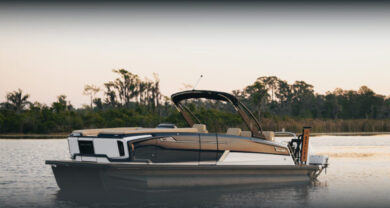Water access solutions debated
WASHINGTON – Water access was the hot – and controversial – topic of day one of the National Marine Manufacturers Association’s American Boating Congress.
What made the panel discussion most controversial was the involvement of both Genmar Holdings CEO Irwin Jacobs and Brunswick Corp. CEO Dusty McCoy – sitting at opposite ends of the table – among others.
Jacobs, who spoke before McCoy, said that the industry has not been doing a very good job of helping federal, state and local government agencies make decisions that would improve access – or at least prevent the problem from growing.
One significant opportunity for improving water access, Jacobs stated, is in developing waterfront brownfield sites. These government-owned properties, which typically have been polluted with hazardous waste, can be cleaned up and turned into marinas, he suggested.
Jacobs added that such a solution is available to small businesses, not just big companies. When questioned by the audience about funding for clean-up of these sites, Jacobs made vague reference to the availability of government dollars through such groups as the Small Business Administration.
Another point Jacobs made is that the boating industry may need to begin considering moving its access points out of crowded urban areas. He suggested, for example, that boat ramp parking lots may need to be moved from the waterfront, with shuttle buses made available to users.
The Genmar executive tied up his comments by stating that technology will be “the single biggest way” for the industry to ensure a “long and prosperous future.”
Access impacting sales, McCoy suggests
Brunswick’s McCoy began his speech by painting water access as the industry’s biggest issue.
In fact, he sounded a warning note that the industry may already be “losing sales at an alarming rate.”
He used the situation in Florida’s Broward County as illustrative of the problem, stating that 14 percent of its marinas, making up 23 percent of its floating slips, “are getting ready to be lost.”
The county has 38 boat ramps with 1300 parking spaces available for use by the owners of its 3,600 trailerable boats, McCoy said, suggesting that a “bunch of people are not boating.”
As the industry pursues a solution, McCoy said permitting may be one of its biggest obstacles. For example, at Brunswick’s recently purchased marina in Pinellas County, it will take 18 months to obtain the permitting for it to “fix up the place,” he said.
He suggested that “no person in their right mind” would undertake the development of a new marina under current permitting requirements.
The Brunswick CEO begged the industry to support efforts to gather data related to water access, to work with their local communities to provide tools and information on the value marinas offer, to cooperate with government agencies that permit to streamline the process involved in approving efforts to build and refurbish marinas and boat ramps, and to work with government agencies that own waterfront that can be developed as marinas.
After the discussion, it was announced that a National Conference on Water Access will take place in May 2007 at William & Mary, where these and other solutions will hopefully be debated.
Other speakers warn of potential changes
Also sitting on the panel were Rear Admiral Craig Bone, director of inspections and compliance for the U.S. Department of Homeland Security, and Gerald W. Barnes, chief of operations for the US Army Corps of Engineers.
Bone spoke on the importance of safety and security, suggesting that ID cards – or a similar boater identification system – may be necessary to avoid a ban on boating in the case of a security crisis. He also mentioned a need to update the maximum carrying capacity for boats now that a person’s average weight is closer to 170 lbs than the 150 lbs now used as a standard.
Barnes admitted during his speech that recreational projects are “typically a tack-on to other projects” for the Army Corps of Engineers and that “recreational use is sometimes a challenge” given the commercial industry’s requirements. He also warned of an aging infrastructure – including locks and dams – combined with a flat budget in recent years.
Barnes identified trends, such as recreating closer to home, a younger recreating public and tighter security. He also suggested that user fees at recreation areas managed by the Army Corps of Engineers would likely increase.
- For more of the latest news, click here.




